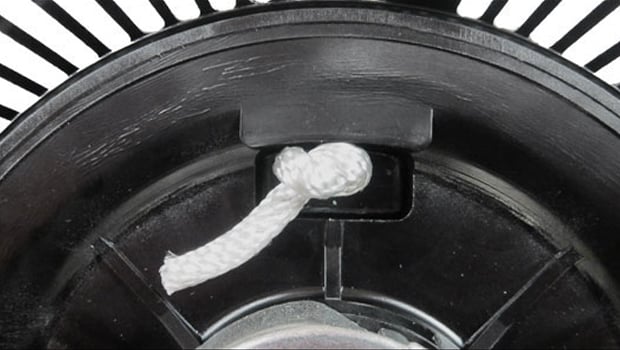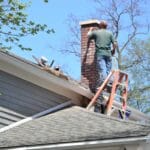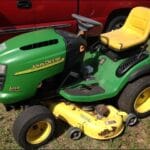You’re all set to tackle the winter wonderland outside, but there’s a problem—your snow blower’s pull cord won’t recoil. It’s frustrating, especially when the snow is piling up and all you want is a clear path.
You might feel stuck, but don’t worry. This common issue has simple solutions that you can easily try at home. Imagine the relief when your snow blower roars back to life, making snow removal a breeze. You’ll discover quick fixes and preventive tips to ensure your machine works flawlessly.
Ready to get your snow blower back in action? Let’s dive in and solve this problem together!
Common Causes
Snow blowers are essential in winter for clearing driveways. Sometimes, their pull cord won’t recoil. Understanding the common causes helps in troubleshooting the problem effectively.
Faulty Recoil Spring
The recoil spring might be broken or loose. This prevents the cord from retracting. Inspect the spring for any visible damage.
Dirty Or Stuck Pulley
A dirty or stuck pulley can hinder the cord’s movement. Check if debris is blocking the pulley. Clean it thoroughly to ensure smooth operation.
Damaged Cord
The cord itself might be frayed or broken. A damaged cord won’t recoil properly. Examine the cord for wear and tear.
Improper Assembly
Sometimes, parts are not assembled correctly. This can affect the recoil mechanism. Ensure all components are aligned and properly fitted.
Frozen Components
Cold weather can freeze parts of the snow blower. Frozen components may cause the cord to stick. Warm up the blower or check for ice buildup.

Credit: www.amazon.com
Inspecting The Cord
Snow blowers are essential for clearing paths during winter. A common issue is the pull cord not recoiling. Addressing this problem requires careful inspection of the cord. It ensures the blower functions smoothly. Let’s explore how to inspect the cord effectively.
Checking For Damage
Start by examining the pull cord thoroughly. Look for fraying or cuts. Damaged cords hinder smooth recoil. Replace cords showing significant wear. A healthy cord promotes efficient operation. Regular checks prevent unexpected breakdowns.
Ensuring Proper Length
The length of the cord affects recoil. Measure the cord to ensure it’s not too short or too long. A short cord struggles to recoil effectively. A long cord can tangle or snag. Adjust the cord to the recommended length. This aids in seamless operation. Proper length enhances functionality and reduces stress on the mechanism.
Examining The Recoil Spring
Troubles with the pull cord not recoiling often point to the recoil spring. Inspect it for damages or loose connections. This spring is vital for the cord’s retraction, ensuring the snow blower starts smoothly. Proper maintenance can prevent future issues and extend the life of your snow blower.
When your snow blower’s pull cord won’t recoil, it can be frustrating, especially when you’re eager to clear your driveway. Often, the issue lies with the recoil spring. Understanding the spring’s role and knowing how to address common problems can save you time and money.Identifying Spring Issues
Start by carefully removing the cover of the recoil housing. A flashlight can help you see inside the compact space. Look for signs of wear or damage on the spring. Is the spring stretched out or broken? If so, it can’t do its job of pulling the cord back. A spring that’s tangled can also cause trouble. Sometimes, debris or dirt might be affecting its function. A clean spring is a happy spring, so ensure it’s free from obstructions.Replacing A Damaged Spring
First, gather your tools: a screwdriver, pliers, and a replacement spring. These can usually be found at your local hardware store or online. Before starting, lay out your tools so they’re within easy reach. Carefully remove the old spring, noting how it’s attached. This will help guide you when installing the new spring. Use pliers to gently remove the spring without causing further damage. Install the new spring, ensuring it’s seated correctly. A small mistake can lead to another malfunction. Once in place, test the cord to ensure it recoils properly. Have you experienced a similar issue with another machine? Perhaps a lawnmower or chainsaw? Share your tips or questions in the comments below. Your insights could help someone else facing a similar challenge.Lubricating The Mechanism
A snow blower pull cord that won’t recoil can be frustrating. Often, the issue lies with the mechanism. Lubricating it can solve the problem. Proper lubrication ensures smooth operation. It prevents wear and tear. This process improves the life of your snow blower.
Selecting The Right Lubricant
Choosing the correct lubricant is crucial. Use a lubricant that withstands cold temperatures. Silicone-based lubricants work well. They provide a smooth glide. Avoid using oil that can thicken in the cold. It can worsen the problem. Read the product label for temperature suitability.
Proper Application Technique
Start by turning off the snow blower. Ensure it is cool to touch. Locate the pull cord mechanism. Clean any visible dirt or debris. Use a cloth or a brush for this step.
Apply the lubricant to the moving parts. Spray evenly on the mechanism. Avoid excess that can drip or pool. Move the pull cord gently. This spreads the lubricant evenly. Check if the cord recoils smoothly. Repeat the process if necessary.
Cleaning The Pulley System
Fixing a snow blower pull cord that won’t recoil involves cleaning the pulley system. Dust and debris can clog it, causing jams. Regular cleaning ensures smooth operation, preventing future issues. Keep your snow blower efficient and ready for use with simple maintenance.
A snow blower is a lifesaver during harsh winters, but when the pull cord won’t recoil, it can feel like your day has come to a halt. A common culprit for this issue is a clogged pulley system. Cleaning the pulley system can often restore function and save you from an unnecessary trip to the repair shop. Let’s delve into how you can effectively clean the pulley system to get your snow blower back in action.Removing Dirt And Debris
Start by carefully removing the snow blower’s housing to access the pulley system. Safety first: ensure the machine is off and the spark plug is disconnected. Once you have access, inspect the pulley for dirt, ice, or any foreign materials. Use a soft brush or cloth to gently clean the area. Dirt and debris can block the pulley, preventing smooth recoil. If you find any stubborn grime, a bit of warm water can help, but avoid soaking the parts.Ensuring Smooth Operation
With the pulley clean, check for any signs of wear or damage. A frayed cord or rusty components can disrupt the recoil mechanism. Replace any damaged parts to ensure the system functions seamlessly. After cleaning, test the cord by pulling it a few times to see if it recoils smoothly. If it doesn’t, consider adding a drop of lubricant to the moving parts. This can enhance the pulley’s motion, ensuring your snow blower starts with ease. Have you ever wondered how often you should clean the pulley system? Regular maintenance every few months can prevent most issues. It’s a small task that can make a big difference in keeping your snow blower ready for the next snowfall.Checking For Obstructions
Inspect the snow blower for any debris blocking the pull cord. Clear away sticks, ice, or compacted snow. These obstructions can prevent the cord from recoiling properly.
Checking for obstructions in your snow blower’s pull cord is crucial. This issue can prevent the cord from recoiling properly. Identifying and resolving obstructions ensures smooth operation. Follow these steps to clear the path and adjust components effectively.Clearing Pathways
Remove any debris blocking the pull cord’s pathway. Ice, snow, and dirt often accumulate. This buildup can obstruct the cord. Carefully inspect the area. Clear away any foreign materials. Use a small brush to reach tight spaces. Ensure the cord moves freely. Regular cleaning prevents future blockages.Adjusting Components
Misaligned components may hinder recoil. Check the alignment of the cord spool. Ensure the cord is correctly wound. Tighten any loose screws or nuts. This secures the cord in place. Examine the tension of the recoil spring. Adjust if necessary. Proper alignment enhances functionality. Follow these steps for optimal performance. Regular maintenance keeps your snow blower efficient.Testing The Recoil System
Snow blower pull cord won’t recoil? Inspect the recoil system for tangled cords or worn-out springs. Proper maintenance ensures smooth operation and prevents frustration. Regular checks help you catch issues early. Keep your snow blower running efficiently through simple troubleshooting steps.
Testing the recoil system of your snow blower is crucial when the pull cord refuses to recoil. This component ensures that the cord rewinds properly, ready for the next use. A malfunction here can leave you stranded in the snow, unable to start your machine. Let’s dive into how you can assess and adjust the recoil system to get your snow blower back in action.Assessing Functionality
First, remove the snow blower’s housing to access the recoil system. It might sound intimidating, but it’s often a simple task. Check if any debris is obstructing the recoil mechanism. A small twig or ice can easily cause the system to jam. Next, gently pull the cord to see if it moves freely. If there’s resistance or it doesn’t retract, the problem likely lies within the spring mechanism. In some cases, the spring might be broken or loose. You can often identify this by listening for unusual sounds like grinding or clicking. Finally, inspect the cord itself for any wear and tear. A frayed cord can affect the recoil function. If it’s worn out, replacing it might be the quickest fix. Have you ever noticed how a simple change can make all the difference?Final Adjustments
If you’ve identified issues with the spring, consider tightening or replacing it. A properly tensioned spring is key to a smooth recoil. Many users find that adjusting the spring tension can solve persistent problems. Reassemble the housing and test the pull cord again. Ensure everything is aligned correctly. Misalignment can lead to further complications down the road. Lastly, lubricate the moving parts of the recoil system. A little lubrication can go a long way in preventing future jams. Are you maintaining your tools regularly to avoid these small hiccups? By addressing these areas, your snow blower should be ready to tackle the winter ahead. Always remember, maintaining your equipment not only extends its life but also saves you from unexpected breakdowns.
Credit: www.youtube.com

Credit: www.jackssmallengines.com
Frequently Asked Questions
Why Won’t My Snow Blower Pull Cord Recoil?
The recoil issue might be due to a tangled cord. Check for dirt in the recoil starter.
How Do I Fix A Stuck Snow Blower Pull Cord?
First, inspect the cord for knots or damage. Then, clean and lubricate the recoil mechanism.
What Causes A Snow Blower Pull Cord To Jam?
Dirt buildup or damaged parts can jam the cord. Regular cleaning prevents this issue.
Can I Lubricate A Snow Blower Recoil Starter?
Yes, lubricating helps smooth operation. Use a light oil for best results.
Is Replacing The Pull Cord Difficult?
Replacing the pull cord is simple. Follow the manual for step-by-step instructions.
Conclusion
Fixing a snow blower pull cord can be simple. Follow the steps to diagnose the problem. Check for knots or tangles in the cord. Make sure the recoil mechanism is clean. Lubricate if necessary. Regular maintenance prevents future issues. A working snow blower is essential in winter.
Troubleshooting saves time and money. Enjoy the smooth operation of your machine. Keep your driveway clear and safe. No more frustration with stubborn cords. Ready for the next snowstorm? Your snow blower is too. Stay prepared and keep your equipment in top shape.





